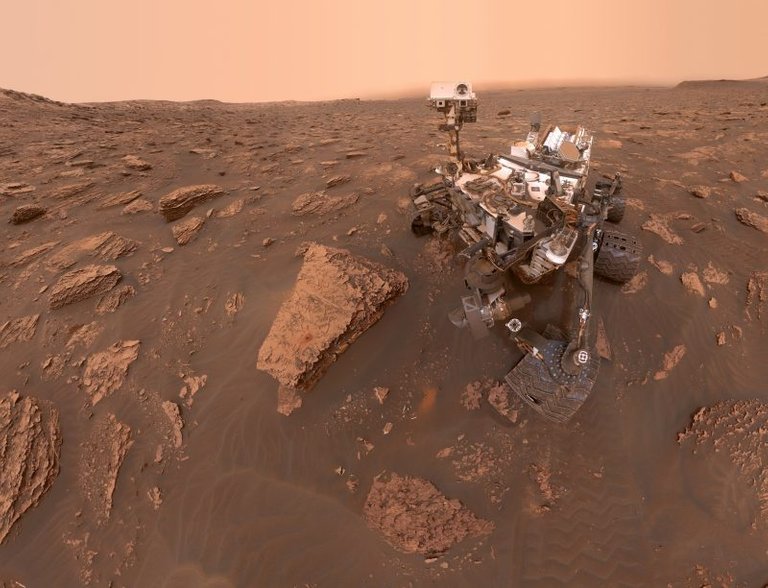Curiosity experiences a global blackout
It's been a while since I posted anything, but with school coming to an end, grading and finishing year-end tasks this has taken up most of my time. With that said, let's dive into my new topic on Mars: Global Blackout.
As many of you know, Mars is experiencing a major dust storm which has caused problems with the Curiosity Rover. As depicted in the Mars miniseries, Mars experiences dust storms that can kick up enough material to block the Sun. These storms are normally seasonal and occur when Mars orbit is closest to the sun (called perihelion). What makes this storm unique is that it has spread so large it encompasses the entire planet as it has now. The previous time this happened was in 2007 (Byrd, 2018).

Photo Credit: NASA/JPL-Caltech/MSSS
As you can see in the picture, sunlight is having a difficult time penetrating the storm.
What's next?
With the ongoing storm, the Opportunity Rover may go dead since it can not recharge its batteries from solar power. Curiosity does not have this problem since it has nuclear power to keep it alive. This creates an incoming problem for the Insight mission which was launched in May. If Insight must land during this storm, NASA will need to modify its landing procedures in order to counter issues associated with the storm.
With these challenges come new discoveries. NASA was able to study the 2007 dust storm and determine a link with gas escaping the Mars atmosphere. NASA's MAVEN mission is situated to further this study in learning about Mars atmosphere (NASA, 2018). Additionally, there are the Mars Reconnaissance Orbiter, Mars Express, and Mars Odyssey which will provide valuable research data as they continue to study both Mars atmosphere and surface.
Human Presence
One final thing to consider is the effect such weather has on astronauts that first arrive and settle on Mars. As depicted in the Mars miniseries, one of the biologists was so severely affected psychologically that he opened a hatch door which caused decompression and death. Could such an event happen in real life and what precautions will NASA take to ensure this does not happen? I'm sure each of you has been affected by the weather in some way or another. Too much rain brings depression. I saw that while living in Seattle. But when the Sun came out, it was like living in paradise. Others are affected by winter weather. How will astronauts handle the pressures associated with a mission so far from Earth and how will these dust storms make this worse. What are your thoughts? How would this affect you?

Mars dust storms are seasonal and the Insight mission is slated to land in November:
https://en.wikipedia.org/wiki/InSight
Mars dust storms also kill the sunlight, cool down the surface and this kills off the wind strength. Let's hope the storm will kill itself off before the landing in November.
InSight
InSight is a robotic lander designed to study the interior of the planet Mars. The mission launched on 5 May 2018 at 11:05 UTC and is expected to land on the surface of Mars (landing site: Elysium Planitia) on 26 November 2018, where it will deploy a seismometer and burrow a heat probe. It will also perform a radio science experiment to study the internal structure of Mars.
The lander was manufactured by Lockheed Martin Space Systems and was originally planned for launch in March 2016.
Peace, Abundance, and Liberty Network (PALnet) Discord Channel. It's a completely public and open space to all members of the Steemit community who voluntarily choose to be there.Congratulations! This post has been upvoted from the communal account, @minnowsupport, by JPederson96 from the Minnow Support Project. It's a witness project run by aggroed, ausbitbank, teamsteem, theprophet0, someguy123, neoxian, followbtcnews, and netuoso. The goal is to help Steemit grow by supporting Minnows. Please find us at the
If you would like to delegate to the Minnow Support Project you can do so by clicking on the following links: 50SP, 100SP, 250SP, 500SP, 1000SP, 5000SP.
Be sure to leave at least 50SP undelegated on your account.
I did not know there were so many Mars Missions.
so interesting that for each problem solved new ones are both found and created.
Interesting your questions about the psychological states of astronauts, and indeed all people.
Vit. D3 can be made from sunlight or taken in its fat soluble from from ghee or from ruminant fat. But there is more to physical and mental health than nutrition and blue or red light exposure.
Socialising is both necessary and healthy, but it is often the cause of much stress due to the value we place on memories and how we do in fact require them to make sense of sensation.
The intelligence of the astronaut goes way beyond the ability to remember and repeat, or even to use memorised patterns to solve problems quickly.
He must also be a master of self knowledge, so that he can tell when he has become attached to a memory that may cloud his judgement. All this while remaining warm and compassionate from a place of genuine care rather than pride or insecurity.